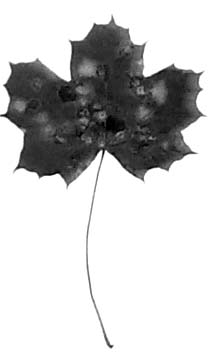
infected with tar spot A heavier than usual infestation of a fungal disease known as Tar Spot has developed on area maple trees due to, in part, wet and cool spring weather. Tar spot most commonly affects the leaves of Silver and Norway maples, but lesions can also appear on the leaves of red and sugar maples, too. Tar spots first appear on fully mature leaves in late spring or early summer. They begin as light green or yellowish circles. Mid-to-late summer, raised black tar-like spots 1/8 to 1/2 of an inch in diameter develop within the yellowish circles. Liz Berkeley, horticulturist at Cornell Cooperative Extension in Monroe County says, "Because it's happening late in the season it doesn't really cause a big problem health-wise for the tree. It's more of an aesthetic blight." Tar spots are rarely injurious enough to require fungicide treatment, although in some cases application of pesticide is advised. Infestations two or three years in a row can lead to some weakening or damage to trees as happened in Ithaca a few years ago. Control of the fungus begins with raking fallen leaves in the fall and disposing of them. Infected leaves can be composted if the leaves are well turned and covered. "Basically, it amounts to sanitation," says Berkeley. "Clean up leaves that fall and not leave them around for the inoculums to stick around until next spring. For this to be most effective it needs to be done on a communitywide basis. For information call Cornell Cooperative Extension's Garden Helpline, 461-1000. |
